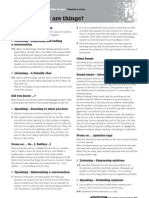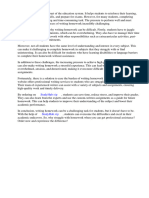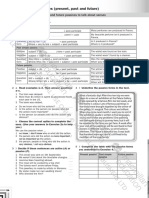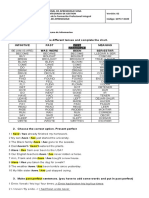Copyright © UCLES 2021 All details are correct at the time of publication in February 2021. 1
A2 Key for Schools Lesson plan poster - free time activity
Aim
: To develop learners’
language to discuss likes and dislikes, using adjectives; to practise speaking and pronunciation.
Level
: A2
Time
: 40 minutes to 1 hour
Materials and preparation
: A2 Key classroom poster, with the language section at the bottom covered up; Handout 1.
Procedure
Warm-up activity
1.
To introduce the topic, ask learners to work in pairs and make a list of hobbies and activities. Ask for one or two examples in open class, to get them started, and to check that they have understood the instruction.
Tell learners that only one student in each pair needs to write. Check understanding by asking the ‘writer’ in
each pair to raise their hand. Give learners one minute to produce their lists, encouraging them to write down as many free-time activities as possible. 2.
Ask learners:
How many hobbies do you have?
Ask the pair with the highest number to read out their list while the rest of the class listens and ticks any activities mentioned that also appear on their lists. Praise
learners’
good answers and re-formulate errors with the correct grammar or vocabulary.
Lead-in to the speaking task
1.
Show learners the poster and ask:
What is the activity in the first picture?
(e.g.
playing musical instruments; playing the guitar; learning to play a musical instrument; taking music lessons
) The activity could be worded in a number of different ways, but the general topic is playing musical instruments. Ask learners to work in pairs to identify the activities represented in the other four pictures (e.g.
playing basketball; surfing; eating outdoors; shopping
).
Give them one to two minutes to identify these before doing a quick whole-class check. 2.
Ask learners:
Do you like playing musical instruments?
Nominate a strong or confident student to answer the question. If the learner only answers,
yes
or
no
, prompt them to elaborate by asking
why (not)?
Praise learners who expand on their answer, and write reasons given for liking/disliking on the board, reformulating as necessary. So, for example, if a student says,
I like the guitar
or just says,
It’s
nice
, write
because it’s nice
on the board. Encourage reactions from the rest of the class by asking:
Do you agree? Why (not)?
Repeat for
playing basketball
, nominating a different student or eliciting responses from volunteers. Again, put their reasons, focusing on adjectives, on the board and praise all efforts at elaborating on answers.

Copyright © UCLES 2021 All details are correct at the time of publication in February 2021. 2
Focus on lexis (adjectives)
1.
Pointing to the adjectives
you’ve just
written on the board, ask learners to think of more adjectives that they could use to describe the activities in the pictures. If all adjectives on the board are positive, elicit one or two negative adjectives in open class, and vice versa. Again, give learners one to two minutes to write down as many adjectives as they can think of, in their pairs. Introduce an element of competition by asking:
Who can write the longest list of adjectives?
Monitor to see which adjectives your learners are coming up with, and also to make a note of any common misspellings you might choose to focus on, later. 2.
Ask learners:
How many adjectives do you have?
Congratulate the pair with the most. Get pairs to swap their list with another pair. Ask:
Did you have the same adjectives? Did you have any different ones?
To focus them on meaning, you could ask pairs to put a smiley face next to positive adjectives and a sad face next to negative ones. 3.
Uncover the language section from the bottom of the poster. Ask learners to compare their adjectives with those on the poster. Ask:
Who had
‘
fun
’
on their list?
Do this for a few, but not all, of the adjectives. Target those which you think your learners will be least familiar with, and use this as an opportunity to clarify meaning by asking concept-check questions, for example:
Do we use
‘
awesome
’
to talk about something we
like or don’t l
ike?
(something we like);
Do we use
‘
awesome
’
to talk about something we like a little bit or something we like a lot?
(something we like a lot);
Can you think of an example of something that’s
scary
?; Are rabbits scary?
(no);
Are spiders scary, for some people?
(yes). 4.
Distribute
Handout 1
. 5.
Optional
: If your learners would benefit from more work on meaning, get them to write one or two activities, things or places next to the adjective they would use to describe it/them. Alternatively, you could ask them to invent emojis to represent each one.
Focus on pronunciation
1.
Ask learners:
How many syllables are there in
‘
fun
’
?
(one);
What about in
‘
boring
’
?
(two). Tell learners to write down the number of syllables in each of the adjectives on Handout 1. Encourage them to work in pairs. Allow about two minutes for this stage, and then do a quick check in open class.
i.
Answers
one syllable:
fun;
two syllables:
b
o
ring
,
sc
a
ry
,
a
wesome
;
three syllables:
exc
i
ting
,
br
i
lliant
,
am
a
zing
,
d
i
fficult
,
d
a
ngerous
,
exp
e
nsive
,
h
o
rrible
; four syllables:
i
nteresting
2.
Elicit the stressed syllable in
boring
. Tell pairs to underline the stressed syllable in each of the adjectives, on Handout 1. Give them a minute or two, encouraging them to try to say the word out loud as they do this, to help them. (Stressed syllables appear in bold in the answer key, above.) 3.
Conduct feedback in open class, modelling correct pronunciation to clarify answers. Drill and encourage learners to repeat chorally, first as a class, then perhaps by row, then perhaps all girls/boys, etc. Drill chunks rather than single items, e.g.
because it’s fun.
Don’t be afraid to exaggerate
the stress. 4.
You could encourage learners to make the face that corresponds to the meaning of the adjective as they say it. Be prepared to demonstrate this yourself! 5.
Another option is to get learners to clap on the stressed syllable as they repeat the word.
Copyright © UCLES 2021 All details are correct at the time of publication in February 2021. 3
The task
1.
Put learners
into groups of three, and ask them to decide who’s A, who’s B and who’s C. Ask all ‘Cs’ to raise
their hands. Tell them that Cs are going to be the examiners. A and B are going to talk about the different free time activities in the pictures, together, for about a minute
. They must say if they like or don’t like each
activity and why.
‘
Examiners
’
must listen and put an A next to each adjective (on Handout 1) student A uses, and a B next to each adjective student B uses. Adjectives can be used more than once
–
and each use will be
‘tallied’
–
but adjectives must be used correctly. To clarify this, write the following on the board: 1
I like
surfing because it’s fun
; 2
I like eating outdoors because it’s horrible.
Ask:
Is sentence 1 a possible correct sentence?
(yes);
What about sentence 2?
(no). Elicit/clarify that we wouldn’t generally use
horrible
to talk about something we like. 2.
Tell A and B that they must talk together for at least one minute.
Note: In the A2 Key/Key for schools Speaking Exam, Part 2, Phase 1, candidates speak together for 1
–
2 minutes and should take it in turns to speak. In Part 2, Phase 2, each candidate is asked two questions on the same topic.
In your lesson, if the majority of your learners are still talking at the one-minute mark, allow them to talk longer. Stop them after about two minutes. 3.
While learners are performing the task, write the closing question on the board:
Which of these free time activities do you like best?
Draw C’s attention to this question
after A and B’s turn has finished
and tell them they should direct this question to A and B, in turn. Take feedback from C on the answers given by A and B, in open class. 4.
Tell Cs to count up the number of times that A and B use adjectives. Ask:
Who used adjectives the most, A or B?
Praise the
‘winner’
in each pair. 5.
Rotate roles and repeat the task. You could ask
‘new’
Cs to perform the same tallying-of-adjectives-used task or you could ask them to focus on one of the following. Whichever focus you choose, ensure that the whole class is aware of what the focus is, and monitor to gauge which areas of interactive communication, language, and pronunciation your learners are strong on, and where more work is required. a.
Which of the ‘candidates’ asks questions most? Here, C needs a piece of paper with the names of ‘A’ and ‘B’ at the top. Each time
they ask a question, C writes a tick under their name. Again, the learner with the most ticks, wins. You may wish to do some language work on the questions that appear on the poster, beforehand. b.
Which of the candidates responds to what their partner has said, most? Be explicit about what this looks like. You could focus on the use of
too
, for example, so if A says
I like shopping because it’s fun
and B responds with something like,
I like shopping too
or
Me too
, this counts as an incident of responding to what your partner has said for B. This would serve as useful practice of the negative
me neither
or as a springboard into introducing your learners to this language. 6.
While monitoring, make a note of commonly occurring errors to focus on either during delayed error feedback during this class, or to inform subsequent classes where the focus might be more language rather than skills-based. Also, make a note of where your learners are succeeding
–
this could be with skills (interactive communication) or language (vocabulary, grammar, or pronunciation)
–
and give them positive feedback on this, highlighting the examples you noted.
Variation
Prior to repeating the task (See:
The task
point 5
.), you could elicit a different set of free time activities from the class for your learners to discuss. The language focus (adjectives) and the interactive communication focuses suggested above will remain relevant.
Copyright © UCLES 2021 All details are correct at the time of publication in February 2021. 4
Handout 1
fun scary brilliant interesting difficult boring dangerous exciting expensive amazing awesome horrible
Handout 1
fun scary brilliant interesting difficult boring dangerous exciting expensive amazing awesome horrible



























































































